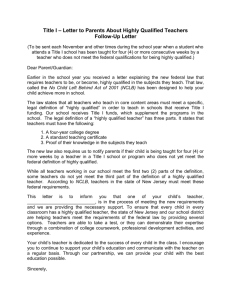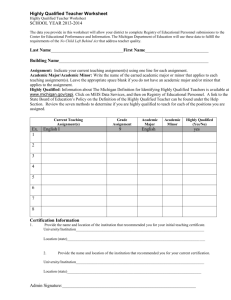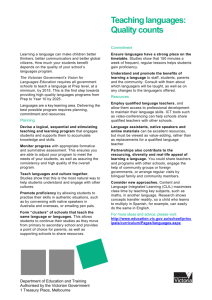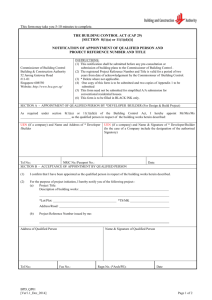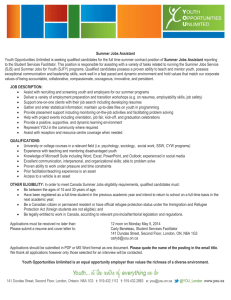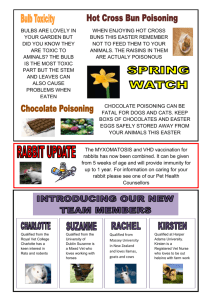Council Business Plan
advertisement
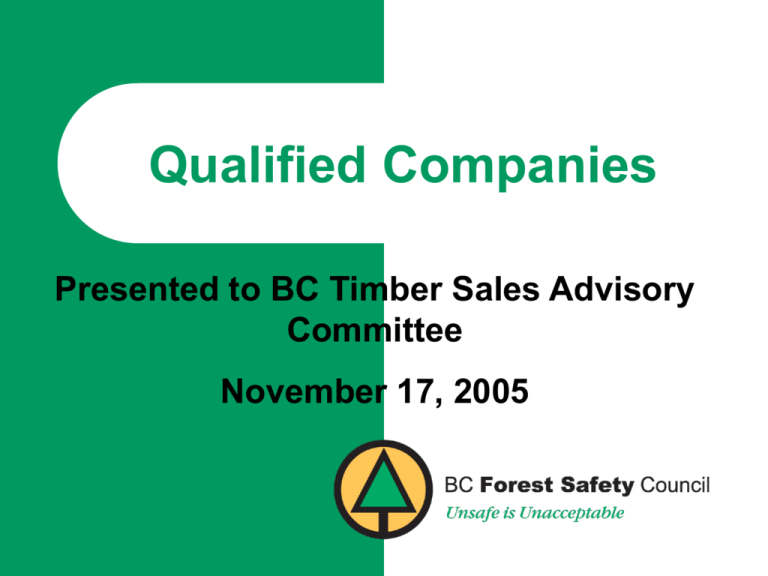
Qualified Companies Presented to BC Timber Sales Advisory Committee November 17, 2005 About the Council Origin: A direct result of the Forest Safety Task Force Our Mission: To eliminate fatalities and serious injuries in the forest sector Organization: Focused policy and advocacy role. Program delivery from the sector Composition: All key forestry organizations, government agencies and ministries at the table and well represented Scope: The initial focus is on the harvesting sector BCFSC Council Members Board Executive Jim Shepherd Chair Keith Playfair Vice Chair Ron Corbeil Secretary Treasurer Board of Directors Roy Nagel Central Interior Logging Association (CILA) Keith Playfair Central Interior Logging Association (CILA) Rick Jeffery Coast Forest Products Association (Coast Forest) John Allan Council of Forest Industries (COFI) Wayne Lintott Interior Logging Association (ILA) Jim Hackett Interior Lumber Manufacturers’ Association (ILMA) Bill Sauer North West Loggers Association (NWLA) Ron Corbeil Steelworkers – IWA Council (IWA) Jim Girvan Truck Loggers Association (TLA) Mike McKibbin Western Fallers’ Association (WFA) John Betts Western Silvicultural Contractors’ Association (WSCA) Grant Parnell BC Timber Sales (BCTS) Trish Balcaen Ministry of Forests (MOF) Betty Pirs Workers’ Compensation Board (WCB) Areas of Focus Cultural Change A Safety Aware Legal Regime Confident and Competent Workers Qualified Companies BC Forest Safety Council 4 Workplan Priorities • Faller Certification • Safe Silviculture • Forestry TruckSafe • Qualified Companies Where We Stand Today Logging…... High Injury Rate High Costs Questions around health and safety responsibilities in a multi-layered industry Fatalities At this rate, every 2 weeks a forestry worker does not return home at the end of the day 9 times higher than work fatalities for all of BC combined 37 Fatalities in 2005 THIS IS UNACCEPTABLE! Not killed, but… Our injury rate was twice Every year, therethe a 3provincial average serious injuries per 1000 workers. the rate last 10 years, Our seriousOver injury was twice as high as there have been 981 other high risk industries serious injuries – that is over 80 serious injuries a Serious injuries make up 16% of the year. ---claims volume, but are 85% of the total claims ---cost THIS IS UNACCEPTABLE! Costs are High and Escalating Base Rate one of the The Rate for 2004 was highest $10.74;in forProvince 2005, $11.39. WCB Base Rate - High Risk Industries $12.00 $10.00 Bas Rate $8.00 Forestry - DR Sawmill - CZ $6.00 Construction - DG $4.00 $2.00 $2003 2004 2005 The New Industry Timber Sales BC Ministry of Forests WCB Integrated Forest A high and increasing Company percentage of the cost of injuries and the fatalites Workforce that occur are with small companies, and they are Workers increasing. New Players & “Licencees” Prime Contractor Sub-Contractor Sub-Contractor IWA Sub-Sub-Contractor Sub-Sub-Contractor Sub-Sub-Contractor The requirements of safety – training, safety reviews, safety alerts, investigations, notices, remedial actions – need to be reviewed in light of these changes. Qualified Companies Distinguishes forestry employers who: 1. Meet a level of Safety Standards 2. Demonstrate true commitment and leadership to a culture where the health and safety of all workers is an overriding priority. SAFE Audit - Components Safety Accord Forestry Enterprise Requirements: • SAFE Audit Evaluation Components: • • • • • • • • Management Commitment and Company Policy Hazard Identification and Control Rules and Work Procedures Safety Communication Training, Education, and Certification Incident Reporting and Investigation Shared Safety Responsibility – Contractor Management Disability Management A Qualified Company will…. Management Programs Have a written health and safety policy Discuss managements, supervisors, employees, and contractors responsibilities for health and safety Promote, share, and discuss the BC Forest Industry Health and Safety Accord Senior managers and supervisors must access the operations on an ongoing basis, and discuss health and safety issues with workers and contractors. A Qualified Company will…. Risk and Hazard Management Ensure that the risks of the operation have been evaluated Identify all hazards in the work processes and ensure that adequate controls are in place to reduce the possibility of an incident from occurring Conduct training in hazard identification and control with employees Conduct facility inspections and audits Perform maintenance on equipment A Qualified Company will…. Standards, Procedures, and Work Instruction Having all workers and contractors following the safety rules and regulations, including PPE and SPAC’s Ensure that the jobsite or facility is meeting the regulatory rules Have applicable legislation available for review by all levels of employees Ensure that the ER procedures are established, functional, clearly known, understood by all levels of employees, and test the plan on a regular and ongoing basis A Qualified Company will…. Training, Education, and Certification Orientations are given to new-hire workers, employees returning after a significant time period, contractors and sub-contractors, and visitors The right to refuse unsafe work is clearly understood by all employees Where applicable, an on the job training program is formal in nature, and specific in the requirements to meet certain standards Certification is validated before work begins, and the expiry dates are tracked to ensure that workers are current in their tickets. A Qualified Company will…. Health and Safety Communications Regular safety meetings are being held, with active participation by employees, contractors, and subcontractors Deficiencies identified during safety meetings are dealt with in a timely and effective manner There is a formal and active close call reporting system Documentation for inspections and audits are retained by the company A Qualified Company will…. Incident Reporting and Investigations A written standard for reporting of incidents, and the investigation of these incidents The inclusion of a root cause analysis for investigations, and for education and training of investigators A method of implementing investigator recommendations A standard, monthly and yearly evaluation of statistics The introduction of a safety alert for each incident, including the requirement to share these alerts with the industry where applicable A Qualified Company will…. Contractor Management Results from the Shared Safety Responsibility Review Select their contractors based on an objective selection criteria which includes safety Have a requirement for consistent safety performance improvement from their contractors Is ensuring that any company having prime contractor status is performing their duties in accordance with the regulations and consistent with good safety practices A Qualified Company will…. Disability Management Has a DM program, it is known to all levels of employees, and management is committed to the process There is a DM committee, which ultimately makes recommendations to management There is one individual who is ultimately responsible for the DM Program The company has a RTW and SAW Programs within the program and is effectively utilizing these SAFE Companies Safety Accord Forestry Enterprise SAFE Companies will also be Industry leaders in changing the safety culture • Actively share safety information – Safety Alerts • Committed to Industry Recognized Practices (IRP’s) • Practice shared responsibility in the sector’s multilayered structure Qualified Companies Safety Accord Forestry Enterprise SAFE Companies will earn a 5% rebate on WCB premiums annually • • • Be recognized for pre-qualification standards required to work in BC Forests Ensure a qualified work force Attract customers in an increasing competitive market Additional benefits: Improved worker well being Reduced incident costs (direct and indirect) Improved productivity Lower WCB premiums (Base Rate & Experience Rating) Saving Money Through Safety – Part 1 1:3 Direct/Indirect Cost Ratio Indirect Costs Direct Costs Medical/Rehab Costs Impacts on Family and Community •Average claims cost (2005 WCB figure) Damage to •IndirectCorporate CostImage to your company Downtime for Staff to Cope Production Downtime Total Cost Reduced Morale Investigation Costs Training for Replacement Worker Re-orientation for Returning Worker $30,000 $90,000 Repair Costs First Aid - supplies ambulance Sick pay $120,000 WCB Premium Increases (Experience Rating and Base Rate) WCB fines Legal costs Experience Rating Benefits ABC: Excellent Safety Performance = DISCOUNT ID Company ABC Company XYZ Base Rate $ 9.35 $ 9.35 Experience Rating -45 80 Net Rate $ 5.14 $ 17.30 Assessable Payroll $ 2,000,000 $ 2,000,000 XYZ: Poor Safety Performance = SURCHARGE WCB Premiums $ 102,800.00 $ 346,000.00 $ 243,200.00 For Success….. Significantly change how Industry approaches Safety Requires the ENTIRE sector to take collective responsibility and action for Safety For Success….. Costs to the sector - the benefits will outweigh the costs Similar programs have successfully reduced injuries while creating substantial saving for employers What does QC mean for BCTS Get Involved in Safety Short term Long term • Put on a safety lens • Involvement in Industry/Council Safety Initiatives • Requiring Qualified Companies at pre-qualification • standards for bidding on timber by XX/XX/200X Practice shared responsibility Benefits to BCTS BC Timber Sale’s Mission: ….”capture the value of the asset for the public.” A Qualified Company will be productive company • Higher Quality • Higher Utilization • Forest Stewardship Qualified = Productive “Excellence in safety is compatible with excellence in other business parameters such as quality, productivity and profitability.” “Safe, healthy employees have positive impacts on all operations. They have positive effects on customers and enhance credibility in the marketplace and in the community.” - J.M Stewart, DuPont Canada, U of T Activities – Making the Case AB Experience Report Cost of Unsafe Analysis Shared Safety Responsibility Review Understanding your WCB Assessment Stakeholders Discussions Activities – Developing the Structure SAFE Companies Program Development – Fall 2005 • SAFE Companies Audit BASE SEBASE Auditor Infrastructure • IRP Development and Participation • Better Information Sharing Safety Alerts Safety Investigations Activities – Refining Structure Working with Industry to Refine Program Components • Qualified Companies Advisory Committee (QCAC) • TAC Team (Technical Advisory Committee) Engagement in WCB’s Certificate of Recognition (COR) Program SAFE Companies Pilots Discussion For more information: Krista Bax – 604-891-1246 Keith Rush – 604-891-1247 www.bcforestsafe.org Qualified Companies Presented to BC Timber Sales Advisory Committee November 17, 2005
